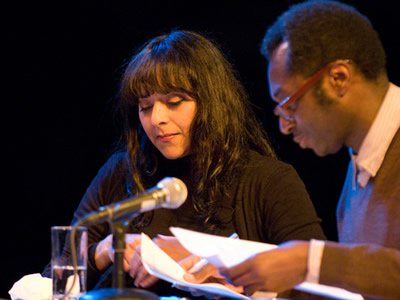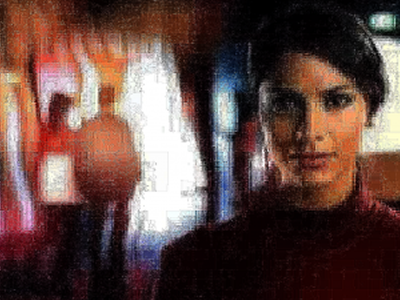Syracuse Symposium™ Celebrates Cinematic Artistry of Otolith Group Nov. 12
Everson Museum will host discussion, screenings by acclaimed British arts collective

Syracuse SymposiumTM continues its “Networks” them with an evening devoted to cutting-edge filmmaking.
The Otolith Group, an award-winning London-based artist collective, will be the focus of a special event on Thursday, Nov. 12, at 6:30 p.m. in Hosmer Auditorium of the Everson Museum of Art (401 Harrison St.). The program features an indoor screening of works by the group, including Anathema (2011), as well as a live stream of an interview with co-founder Kodwo Eshun.
The program, which is free and open to the public, includes a reception. For more information, contact the Syracuse University Humanities Center in the College of Arts and Sciences at 315-443-7192 or visit syracusehumanities.org.
The evening is also part of a yearlong program titled "We Were Never Human," involving the Urban Video Project (UVP) and its parent organization, Light Work.
“Kodwo Eshun uses film essays to examine lived conditions, engage current events, and unpack history,” says Vivian May, director of the Humanities Center and associate professor of women’s & gender studies. “Working at the nexus of visual culture and contemporary art, Eshun—and, by extension, The Otolith Group—seeks to rethink cultural production in the context of precarious global conditions. This work approaches film in new and important ways.”
Eshun founded the Otolith Group with Anjalika Sagar in 2002. Since then, the collective has exhibited, installed, and screened works all over the world. Many of the group's projects are commissioned by public and private organizations, and involve research, installations, and publications.
No doubt that the Otolith Group’s self-described “collaborative and discursive practice” is an extension of its founders’ liberal arts training. (Eshun studied English literature at University College, Oxford; Sagar, anthropology and Hindi at the University of London.) Hence, their films and solo exhibitions, which number in the dozens, draw on material found within a range of disciplines, particularly the moving image.
“[Our] work is formally engaged with research-led projects, exploring the legacies and potentialities of artist-led proposals around the document and the essay film, the archive, the aural and sonic medium, speculative futures, and science-fictions,” says Eshun, whose work resides in the Guggenheim Museum in New York City.

“Anathema can be understood as an object-oriented video that isolates and recombines the magical gestures of dream factory capitalism,” she says. “By bringing the telecommunicating couplings of mother-father-daughter-son-machines and boyfriend-girlfriend-units into contact with the conductive imagery of liquid crystallization, [the film] proposes itself as a prototype for a counter-spell assembled from the possible worlds of capitalist sorcery.”
The program is co-sponsored by the UVP and Light Work Visual Studies, administered by Light Work and the University; the Visiting Artist Lecture Series in the School of Art and the Department of Transmedia, both in the College of Visual and Performing Arts; the Coalition of Museums and Art Centers; the Connective Corridor; the Everson Museum of Art; and the New York State Council on the Arts.
The Syracuse University Humanities Center, founded in 2008, fosters public engagement in the humanities, and is home to the Syracuse Symposium™, the Central New York Humanities Corridor, the Jeanette K. Watson Distinguished Visiting Professorship, the Mellon Visiting Collaborator, the HC Mini-Seminar and Symposium Seminar series, the Perpetual Peace Project, and other annual research initiatives, annual fellowships, and public programming.
Media Contact
Rob Enslin
